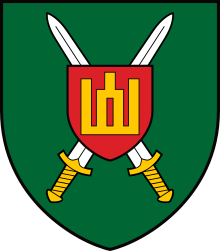Lithuanian Army
| Lithuanian Land Force Lietuvos sausumos pajėgos |
|
|---|---|

Insignia of Land Forces Command
|
|
| Active | 1918–1940 1990–present |
| Country |
|
| Branch | Army |
| Type | Land force |
| Role | Defend territory of Lithuania and act as an integral part of NATO forces |
| Size | 8,120 active duty 4,550 active reserve (volunteers) |
| Part of | Lithuanian Armed Forces |
| Garrison/HQ | Vilnius |
| Motto(s) | "Strength in unity, victory in trust!" |
| Equipment | Lithuanian army equipment |
| Website | Official site |
| Commanders | |
| Current commander |
Brigadier General Valdemaras Rupšys |
| Chief of Staff | Colonel Dalius Polekauskas |
| Chief Warrant Officer | Sergeant Major Osvaldas Žurauskas |
| Insignia | |
| Flag of Lithuanian Land Force |  |
| Flag of Land Forces Command |  |
The Lithuanian Land Forces (LLF) form the backbone of the country's defence force, capable of acting as an integral part of NATO forces. Lithuanian Land Forces consist of two brigades, the Engineer Battalion, and the National Defence Volunteers Division.
The main element of the Land Forces is a single mechanised infantry brigade, the Iron Wolf Mechanised Infantry Brigade. This is formed around three mechanized infantry battalions and an artillery battalion, all named after Lithuanian grand dukes as the tradition of the Lithuanian Armed Forces goes.
In addition to the formed infantry brigade, the Land Forces maintain three additional motorised infantry battalions; one of these is tasked to support operations both domestically and overseas; one is tasked primarily with the defence of territorial Lithuania, and the third is primarily a training unit
Juozas Vitkus Engineer Battalion is responsible for mine clearance, the construction of pontoon bridges, unexploded ordnance detonation tasks, underwater engineering, and participation in search and rescue operations. The Explosive Ordnance Disposal Platoon is ready to participate in international operations. Starting in 2008, the Lithuanian Armed Forces launched a 10-year-long project continuing mine cleaning on Lithuanian territory of explosives left after the First and Second World War, and in former Soviet military bases.
As an integral part of the Land Forces, the National Defence Volunteers have been developing since the beginning of the national movement for independence. The volunteers act smoothly together with the Allies during military operations and have been assigned new missions: to augment the regular forces, to deploy individual units and specific capabilities for international operations, to assist host nation support and to support the civilian authorities.
...
Wikipedia
